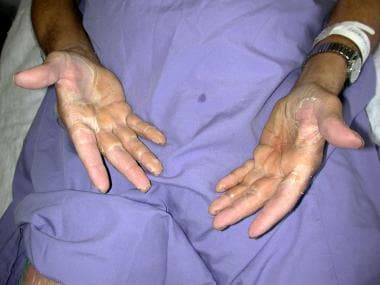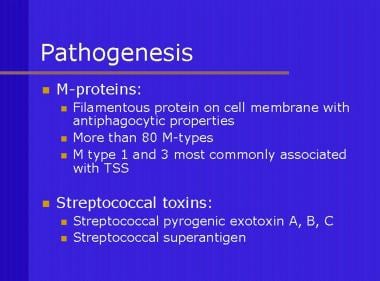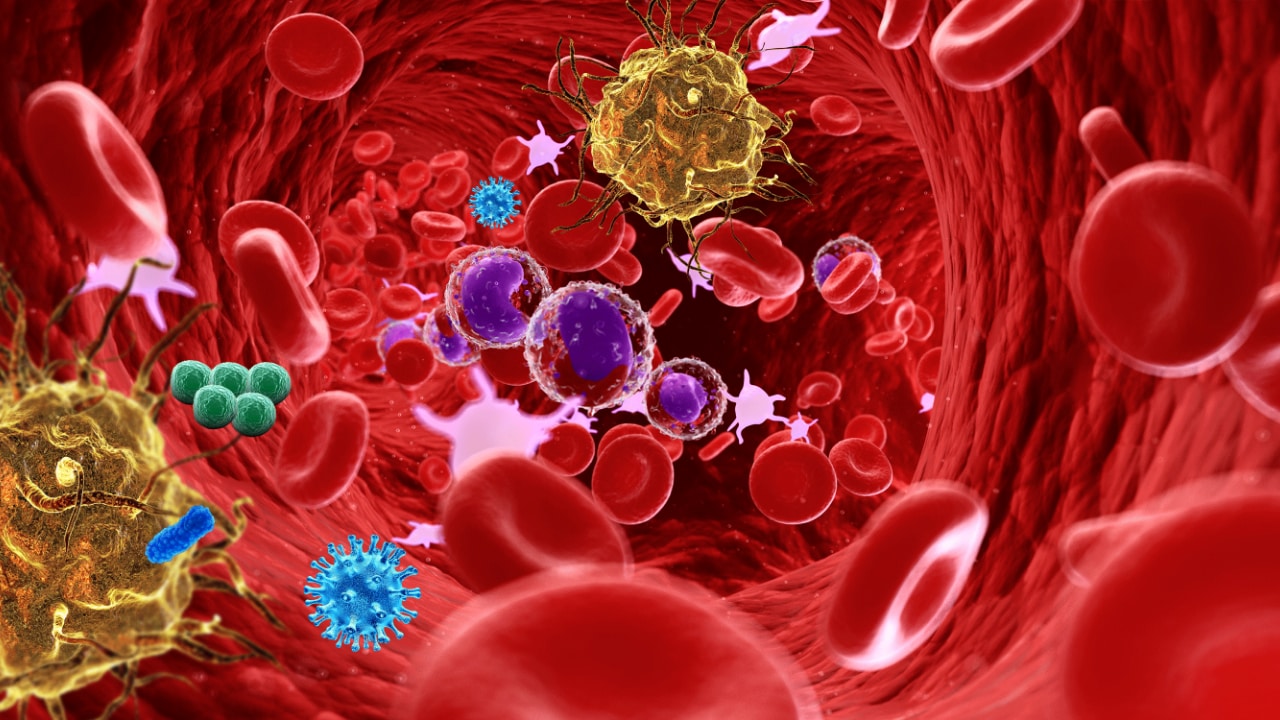Background
Toxic shock syndrome (TSS) is a toxin-mediated acute life-threatening illness, usually precipitated by infection with either Staphylococcus aureus or group A Streptococcus (GAS), also called Streptococcus pyogenes. It is characterized by high fever, rash, hypotension, multiorgan failure (involving at least 3 or more organ systems), and desquamation, typically of the palms and soles, 1-2 weeks after the onset of acute illness. The clinical syndrome can also include severe myalgia, vomiting, diarrhea, headache, and nonfocal neurologic abnormalities.
See the image below.
 A 46-year-old man presented with nonnecrotizing cellulitis and streptococcal toxic shock syndrome. The patient had diffuse erythroderma, a characteristic feature of the syndrome. The patient improved with antibiotics and intravenous gammaglobulin therapy. Several days later, a characteristic desquamation of the skin occurred over palms and soles. Courtesy of Rob Green, MD.
A 46-year-old man presented with nonnecrotizing cellulitis and streptococcal toxic shock syndrome. The patient had diffuse erythroderma, a characteristic feature of the syndrome. The patient improved with antibiotics and intravenous gammaglobulin therapy. Several days later, a characteristic desquamation of the skin occurred over palms and soles. Courtesy of Rob Green, MD.
TSS was first described in children in 1978. [1] Subsequent reports identified an association with tampon use by menstruating women. [2, 3, 4] Menstrual TSS is more likely in women using highly absorbent tampons, using tampons for more days of their cycle, and keeping a single tampon in place for a longer period of time. Over the past two decades, the number of cases of menstrual TSS (1 case per 100,000) has steadily declined; this is thought to be due to the withdrawal of highly absorbent tampons from the market.
Notably, 50% of cases of TSS are not associated with menstruation. Nonmenstrual cases of TSS usually complicate the use of barrier contraceptives, surgical and postpartum wound infections, burns, cutaneous lesions, osteomyelitis, and arthritis. Although most cases of TSS occur in women, about 25% of nonmenstrual cases occur in men.
In the 1980s, Cone initially reported and Stevens subsequently characterized GAS as a pathogen responsible for invasive soft tissue infection ushered by toxic shock–like syndrome. [5, 6] The streptococcal TSS is identical to staphylococcal TSS (STSS), except that the blood cultures usually are positive for staphylococci in STSS. Toxin-producing strains of S aureus infect or colonize people who have risk factors for the development of the syndrome. Most cases are related to the staphylococcal toxin, now called TSS toxin-1 (TSST-1).
GAS is an aerobic gram-positive organism that forms chains and is an important cause of soft tissue infections. Diabetes, alcoholism, varicella infections, and surgical procedures all increase the risk of severe GAS infections and hence may potentially increase the risk of GAS TSS. Severe, invasive GAS infections can cause necrotizing fasciitis and spontaneous gangrenous myositis. An increasing number of severe GAS infections associated with shock and organ failure have been reported. These infections are termed streptococcal TSS. [7] See the image below.
Pathophysiology
Bacteriology
Toxic shock syndrome (TSS) is caused from intoxication by one of several related Staphylococcus aureus exotoxins. The most commonly implicated toxins include TSS toxin type-1 (TSST-1) and Staphylococcal enterotoxin B.
Almost all cases of menstrual TSS and half of all the nonmenstrual cases are caused by TSST-1. Staphylococcal enterotoxin B is the second leading cause of TSS. Other exotoxins such as enterotoxins A, C, D, E, and H contribute to a small number of cases. Seventy to 80% of individuals develop antibody to TSST-1 by adolescence, and 90-95% have such antibody by adulthood. Apart from host immunity status, host-pathogen interaction, local factors (pH, glucose level, magnesium level), and age all have a direct impact on the clinical expression of this toxin-mediated illness.
M protein is an important virulent determinant of GAS; strains lacking M protein are less virulent. M protein is a filamentous protein anchored to the cell membrane, which has antiphagocyte properties. M types 1, 3, 12, and 28 are the most common isolates found in patients with shock and multiorgan failure; furthermore, 3 distinct streptococcal pyrogenic exotoxins (ie, A, B, C) also have been identified. These toxins induce cytotoxicity and pyrogenicity and enhance the lethal effects of endotoxins. Recently, the streptococcal super antigen, a pyrogenic exotoxin, has been isolated from an M-3 strain. In some studies, strains producing exotoxins B and C have been implicated in this syndrome, to a lesser extent.
Mechanism of shock and tissue destruction
Colonization or infection with certain strains of S aureus and GAS is followed by the production of 1 or more toxins. These toxins are absorbed systemically and produce the systemic manifestations of TSS in people who lack a protective antitoxin antibody. Possible mediators of the effects of the toxins are cytokines, such as interleukin 1 (IL-1) and tumor necrosis factor (TNF). Pyrogenic exotoxins induce human mononuclear cells to synthesize TNF-alpha, IL-1-beta, and interleukin 6 (IL-6).
TSS likely relates to the ability of pyrogenic exotoxins of GAS and enterotoxins of S aureus to act as super antigens. Superantigens are molecules that interact with the T-cell receptor in a domain outside of the antigen recognition site and hence are able to activate large numbers of T cells resulting in massive cytokine production. Normally, an antigen has to be taken up, processed by an antigen-presenting cell and expressed at the cell-surface along with class II major histocompatibility complex (MHC). By contrast, superantigens do not require processing by antigen-presenting cells but instead interact directly with the class II MHC molecule. The superantigen-MHC complex then interacts with the T-cell receptor and stimulates large numbers of T cells to cause an exaggerated, dysregulated cytokine response.
In the case of TSS, the implicated exotoxins and several staphylococcal toxins (eg, TSST-1) can stimulate T-cell responses through their ability to bind to both the class II major histocompatibility complex of antigen-presenting cells and T-cell receptors. These toxins simultaneously bind to the beta chain variable region (V-beta) elements on T-cell receptors and the class II major histocompatability antigen-processing cells. This mechanism bypasses the classical antigen-processing procedures and results in excessive T-cell proliferation.
The conventional antigens activate only about 0.01-0.1% of the T-cell population, whereas, the superantigens set in motion 5-30% of the entire T-cell population. The net effect is massive production of cytokines that are capable of mediating shock and tissue injury. As part of this T cell response, interferon–gamma is also produced, which subsequently inhibits polyclonal immunoglobulin production. This failure to develop antibodies may explain why some patients are predisposed to relapse after a first episode of TSS.
Etiology
Acquisition of infection
Risk factors for the development of STSS are tampon use, vaginal colonization with toxin-producing S aureus, and lack of serum antibody to the staphylococcal toxin. [8] STSS also has occurred following use of nasal tampons for procedures of the ears, nose, and throat.
The portal of entry for streptococci is unknown in almost one half of the cases. Procedures such as suction lipectomy, hysterectomy, vaginal delivery, and bone pinning have been identified as the portal of entry in many cases. Most commonly, infection begins at a site of minor local trauma, which may be nonpenetrating. Viral infections, such as varicella and influenza, also have provided a portal of entry.
Epidemiology
US frequency
Estimates from population-based studies have documented an incidence of invasive GAS infection of 1.5-5.2 cases per 100,000 people annually. [9] Approximately 8-14% of these patients also will develop TSS. [10] A history of recent varicella infection markedly increases the risk of infection with GAS to 62.7 cases per 100,000 people per year. Severe soft tissue infections, including necrotizing fasciitis, myositis, or cellulitis, were present in approximately half of the patients.
STSS is much more common, although data on prevalence do not exist. In the United States, from 1979-1996, 5296 cases of STSS were reported. The number of cases of menstrual STSS is estimated at 1 per 100,000. The incidence of nonmenstrual STSS now exceeds menstrual STSS after the hyperabsorbable tampons were removed from the market.
Race
TSS has occurred in all races, although most cases have been reported from North America and Europe.
Sex
STSS most commonly occurs in women, usually those who are using tampons.
Age
Some studies have shown no predilection for any particular age for either the streptococcal TSS or STSS. However, other studies have reported STSS to be more common in older individuals with underlying medical problems. In a Canadian survey, STSS accounted for 6% of cases in individuals younger than 10 years compared with 21% in people older than 60 years. [9] Furthermore, menstruation-associated STSS occurred in younger women who were using tampons.
Prognosis
Mortality rates for streptococcal TSS are 30-70%. [11, 12] Morbidity also is high; in one series, 13 of 20 patients underwent major surgical procedures, such as fasciotomy, surgical debridement, laparotomy, amputation, or hysterectomy. [6, 11]
The case fatality rates for menstrual-related STSS have declined from 5.5% in 1980 to 1.8% in 1996.
Patient Education
Patient education about early signs and symptoms, risk factors and avoidance of tampon use may help prevent relapses. For patient education resources, visit the Women's Health Center. Also, see the patient education article Toxic Shock Syndrome.
-
Description of M proteins and streptococcal toxins.
-
Group A streptococci cause beta hemolysis on blood agar.
-
Group A streptococci on Gram stain of blood isolated from a patient who developed toxic shock syndrome. Courtesy of T. Matthews.
-
This schematic shows interaction among T-cell receptor, superantigen, and class II major histocompatability complex. The binding of superantigen to class II molecules and T-cell receptors is not limited by antigen specificity and lies outside the normal antigen binding sites.
-
Progression of soft tissue swelling to vesicle or bullous formation is an ominous sign and suggests streptococcal shock syndrome. Courtesy of S. Manocha.
-
A 46-year-old man presented with nonnecrotizing cellulitis and streptococcal toxic shock syndrome. The leg was incised to exclude underlying necrotizing infection. Courtesy of Rob Green, MD.
-
A 46-year-old man presented with nonnecrotizing cellulitis and streptococcal toxic shock syndrome. This patient also had streptococcal pharyngitis. Courtesy of Rob Green, MD.
-
A 46-year-old man presented with nonnecrotizing cellulitis and streptococcal toxic shock syndrome. The patient had diffuse erythroderma, a characteristic feature of the syndrome. Courtesy of Rob Green, MD.
-
A 46-year-old man presented with nonnecrotizing cellulitis and streptococcal toxic shock syndrome. The patient had diffuse erythroderma, a characteristic feature of the syndrome. The patient improved with antibiotics and intravenous gammaglobulin therapy. Several days later, a characteristic desquamation of the skin occurred over palms and soles. Courtesy of Rob Green, MD.
-
A 58-year-old patient presented in septic shock. On physical examination, progressive swelling of the right groin was observed. On exploration, necrotizing cellulitis, but not fasciitis, was present. The cultures grew group A streptococci. The patient developed severe shock (toxic shock syndrome). The CT scanning helped evaluate the extent of infection and exclude other pathologies, such as psoas abscess, osteomyelitis, and inguinal hernia.
-
A 58-year-old patient presented in septic shock. On physical examination, progressive swelling of the right groin was observed. On exploration, necrotizing cellulitis, but not fasciitis, was present. The cultures grew group A streptococci. The patient developed severe shock (toxic shock syndrome). The CT scanning helped evaluate the extent of infection and exclude other pathologies, such as psoas abscess, osteomyelitis, and inguinal hernia.
-
A 58-year-old patient presented in septic shock. On physical examination, progressive swelling of the right groin was observed. On exploration, necrotizing cellulitis, but not fasciitis, was present. The cultures grew group A streptococci. The patient developed severe shock (toxic shock syndrome). The CT scanning helped evaluate the extent of infection and exclude other pathologies, such as psoas abscess, osteomyelitis, and inguinal hernia.
-
Necrotizing cellulitis of toxic shock syndrome.
-
Soft-tissue infection secondary to group A streptococci, leading to toxic shock syndrome.
-
Extensive debridement of necrotizing fasciitis of the hand.
-
The hand is healing following aggressive surgical debridement of necrotizing fasciitis of the hand.
-
Necrosis of the little toe of the right foot and cellulitis of the foot secondary to group A streptococci.










